speciation
1/87
There's no tags or description
Looks like no tags are added yet.
Name | Mastery | Learn | Test | Matching | Spaced |
|---|
No study sessions yet.
88 Terms
What is reproductive isolation?
When two populations cannot interbreed and produce fertile, viable offspring.
What happened in the Trinidad mountain river basin species example, and what does it show about speciation?
Between the two river basins, but not within each basin.
In Trinidad, rivers flow down from the mountains and are separated into distinct river basins.
Each river basin is isolated by mountain barriers, preventing movement between them.
Populations within the same basin can interbreed freely — there is no reproductive isolation within a basin.
Populations in different basins do not interbreed — there is reproductive isolation between basins.
This example shows that geographic separation alone (without behavioral or morphological differences) can lead to reproductive isolation.
It supports the idea that physical barriers (like mountains) can initiate the early stages of speciation.
What causes reproductive isolation in some hybrids?
Behavioral differences.
What is macroevolution?
Large-scale evolutionary changes, often leading to new species.
How do lineages maintain their identity?
By staying distinct from other similar lineages.
What defines a species in a phylogenetic context?
A group of populations that form a lineage on a phylogenetic tree.
What is the phenetic species concept?
phenotypic/morphological species concept
Species are grouped by physical appearance and similarity.
putting like individuals together (phenotypically) and making clusters of the traits seen
What is classical taxonomy based on?
Appearance and phenotypic traits.
What are limitations of the phenetic species concept?
Difficulties with analogy vs. homology
Some things don’t fossilize (ex: soft tissue)
Hard to do with really small organisms (ex: bacteria)
Differences in opinion for how many species present
What is the biological species concept?
Species are groups of active or potential interbreeding organisms that are reproductively isolated.
based on reproductive isolation
Do things successfully cross with one another and produce fertile and viable offsping?
gene flow can occur!
What are some shortcomings of the biological species concept?
Hard to test if populations are truly separated
Relies on assumptions (e.g., populations will interbreed potentially)
No gene flow in fossils
Doesn’t apply to asexual organisms
How does natural selection affect separated populations?
It acts on their different environments, leading to genetic divergence.
What is a synapomorphy?
A shared derived trait that defines a clade.
shared derived trait
What is the vicariance model of speciation?
Populations are split by geographic barriers and diverge over time.
genetic drift and selection are more likely to happen in vicariance model
What is parapatric speciation?
Speciation where populations overlap in distribution and may still hybridize.
can look different but there is continuous variation because of selective gradient
What is sympatric speciation?
Speciation where populations overlap but are still different
What is disruptive selection?
Selection against intermediate phenotypes, favoring extremes.
What is phenetic classification?
Grouping species based only on phenotype or observable traits.
What is gene flow?
The transfer of genetic material between populations.
Why is gene flow important for allopatric species definition?
There is gene flow WITHIN a population but none BETWEEN populations, which leads to reproductive isolation and speciation
Why is it hard to define species with fossils?
Because gene flow can't be observed and soft tissues don't fossilize.
Why don't asexual organisms fit the biological species concept?
They reproduce without interbreeding, so reproductive isolation doesn't apply.
What is a niche?
The role an organism plays in its environment, including resource use and interactions.
water
food
shelter
Why can't two species occupy the same niche?
They will compete until one is excluded.
What is geographical isolation?
When populations are physically separated by barriers such as rivers or mountains.
What happens when a large population is split?
Genetic drift and natural selection act differently, leading to divergence.
How can mating behavior lead to speciation?
Different behaviors prevent interbreeding and reinforce isolation.
How can inversions and translocations cause reproductive isolation?
They prevent proper pairing during meiosis, reducing fertility.
What does it mean when species look different but still hybridize?
They may be in parapatric speciation with continuous variation.
What are polymorphisms?
Multiple forms or variants within a population or species.
meaningless when trying to define species
How are species defined from an evolutionary perspective?
Lineages that maintain their identity against other similar lineages that have differences
independent lineages
What does the example of the three Medicago species show about the phenetic species concept?
When plotted in phenotypic space, the individuals form three distinct clusters based on appearance.
These clusters were identified solely by morphological traits (e.g., leaf shape, size, color).
What are some of the pros for the phenetic species concept?
can study asexual populations
can study anything phenotypically
useful with fossils
The biological species concept is not based on ___________ of ____________, but rather is delineates species by __________ possessed by ____________.
attributes; individuals'; properties; populations
Based on populations, not individuals
Focuses on gene flow within populations
No gene flow between populations = different species
What are some strengths of the biological species concept?
Focuses on biological processes (REPRODUCTIVE ISOLATION)
Uses lack of gene flow between clusters of populations to define species
Helpful for defining endangered species
What is the ecological species concept?
A species is defined as a group of organisms that occupy the same ecological niche
interact with the environment in the same way
use the same resources
arrows = direct ecological competition
What advantage does the ecological species concept have over the biological species concept?
can be used for asexual organisms
What is the major disadvantage of the ecological species concept?
hard to define and measure niche
What is the phylogenetic species concept?
focuses on monophyletic clades
looks for smallest phylogenetic clades with at least 1 synapomorphy
How does the phylogenetic species concept differ from the phenetic, biological, and ecological species concepts?
it looks at evolutionary history
What are some of the pros of the phylogenetic species concept?
can look at any living things
can use fossils
asexual reproduction
What are some of the cons of using the phylogenetic species concept?
Can split organisms into too many species
Uncertainty if separated populations will remain separate
Confusion between analogy vs. homology
Problems like long branch attraction can affect results
What does allopatric speciation mean?
populations of species get physically separated
there is reproductive isolation between populations
In all allopatric speciation models, the processes ______________ and _______________ cause populations to diverge from one another
genetic drift ; natural selection
natural selection acts on environmental conditions
genetic drift acts when large population is divided in 2 separate ones divided geographically
What is the peripheral isolate model?
Populations can become geographically isolated when individuals colonize a new habitat
founder effect
small population of parent population gets isolated
lack of gene flow
genetic diversity and natural selection
islands, springs, sea vents, ferns, caves, lakes, ponds, mountain tops
What does the snapping shrimp model regarding the Isthmus of Panama show?
vicariance model
Isthmus of Panama formed, separating the Atlantic and Pacific oceans.
found that species on each side were closely related sister pairs, but reproductively isolated.
DNA sequencing and phylogenetic trees confirmed the species pairs were once connected.
Genetic divergence (e.g., allozymes) was negatively correlated with mating compatibility:
More divergence = less compatibility
None of the shrimp pairs produced fertile offspring, showing postzygotic reproductive isolation.
biological, phenetic, and phylogenetic species concepts
In many plant species, allopatric speciation leads to so-called…..
progenitor-derived species pairs
The progenitor is the original, ancestral species.
The derived species is the new species that split off.
Often found in peripheral isolate model in allopatric speciation (small, isolated population becomes new species).
What does the relationship between black spruce and red spruce reveal about speciation?
Black spruce (in Northern Canada) and red spruce (in New England) are likely a progenitor-derived species pair.
The black spruce is the progenitor (ancestral) species; the red spruce is the derived species.
There is much more genetic (mtDNA) variation in black spruce populations than in red spruce populations.
All mitochondrial haplotypes found in red spruce are a subset of those in black spruce, suggesting red spruce evolved from a portion of black spruce.
Red spruce has less variation because it spread southward from a smaller founder group during post-glacial colonization.
What can cause sympatric selection?
disruptive selection and assortative mating
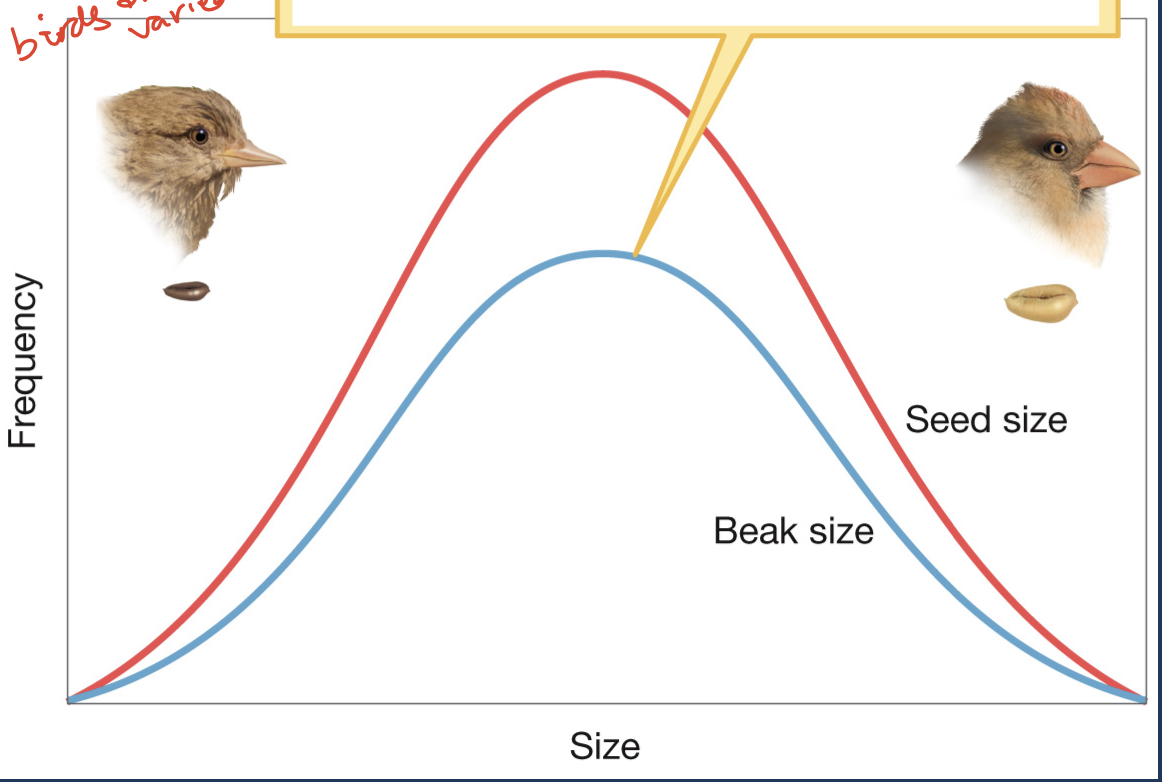
In the following graph about beak size and seed size, what is happening?
Birds with different beak sizes can coexist because their beak size distributions mirror the seed size distributions
they get the same amount of food
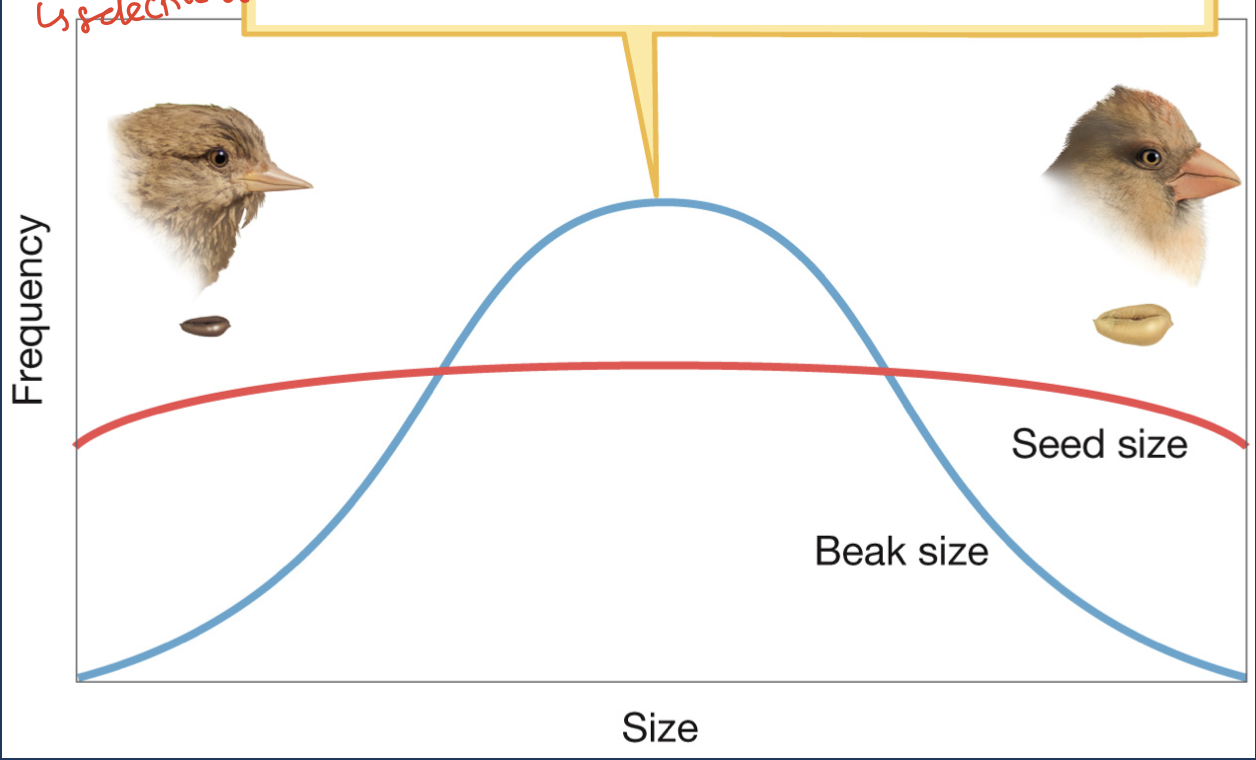
In the following graph about beak size and seed size, what is happening?
There are fewer medium-sized seeds available compared to small and large seeds.
Since many birds have medium-sized beaks, they face high competition and low food availability, putting them at a selective disadvantage.
disruptive selection, favoring birds with either small or large beaks.
What is assortative mating?
when individuals preferentially mate with others that have similar traits (such as size, color, or behavior)
increases reproductive isolation by reducing gene flow
reinforce speciation by keeping genetically distinct populations separate
How does polyploidization lead to sympatric speciation?
Polyploidization changes chromosome number, isolating populations genetically
Causes instant reproductive isolation
Triploid hybrids (4n × 2n → 3n) are usually sterile
Speciation happens without geographic separation
What’s the problem with triploids?
uneven distribution
not viable sex cells
uneven meiosis
Explain the mule in a triploid situation and how it is affected.
mules are strong but they are sterile because of triploids
are offspring between diploid and tetraploid
combine genomes of 2 species
How can polyploidy affect gene flow?
can get phenotypic differences (differences in flower size)
might not get pollination
changes in flowering time
barrier to gene flow
more common in plants than animals
What is allopolypoidy?
when you combine the entire genome of 2 species
Explain the allopolyploidy that occurred in the helenium species
helenium thuberi (2n = 26) + helenium bigelovii (2n = 32) → hybrid with 2n = 29
chromosome doubling: 2n = 29 → 4n = 58
formed the allotetraploid helenium puberulum
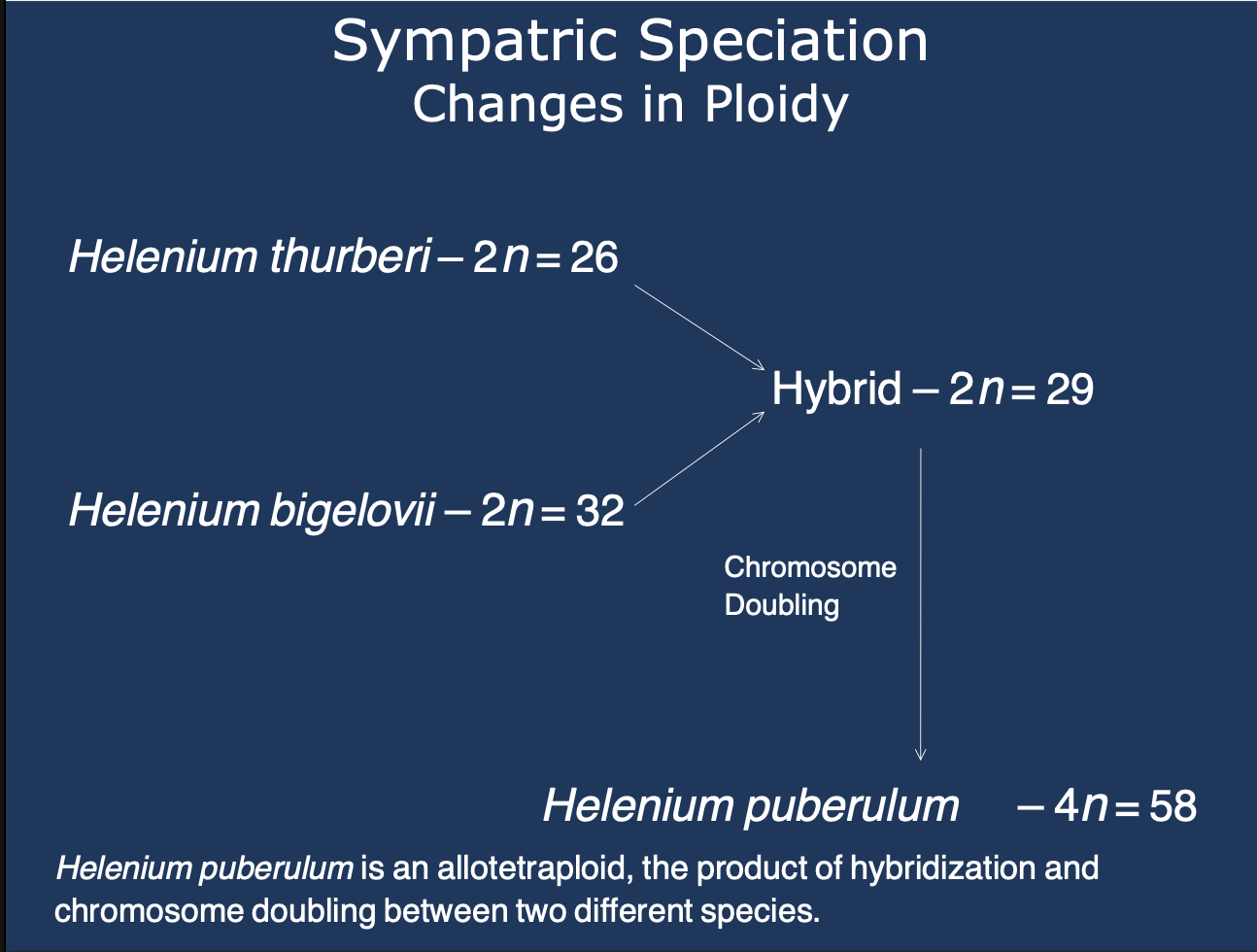
Why would allotetraploids and their diploid parents be reproductively isolated from one another?
Parent A (2n = 6) and Parent B cross (2n = 4)
In meiosis, the allotetraploid offspring has n = 3 + n = 2 gametes, so it has n = 5 gametes
When try to cross allotetraploid with Parent A, the A chromosomes pair together but none of the B chromosomes pair
End up with odd numbers of B chromosome because metaphase plate can’t split a single chromosome
Viable but not fertile offspring
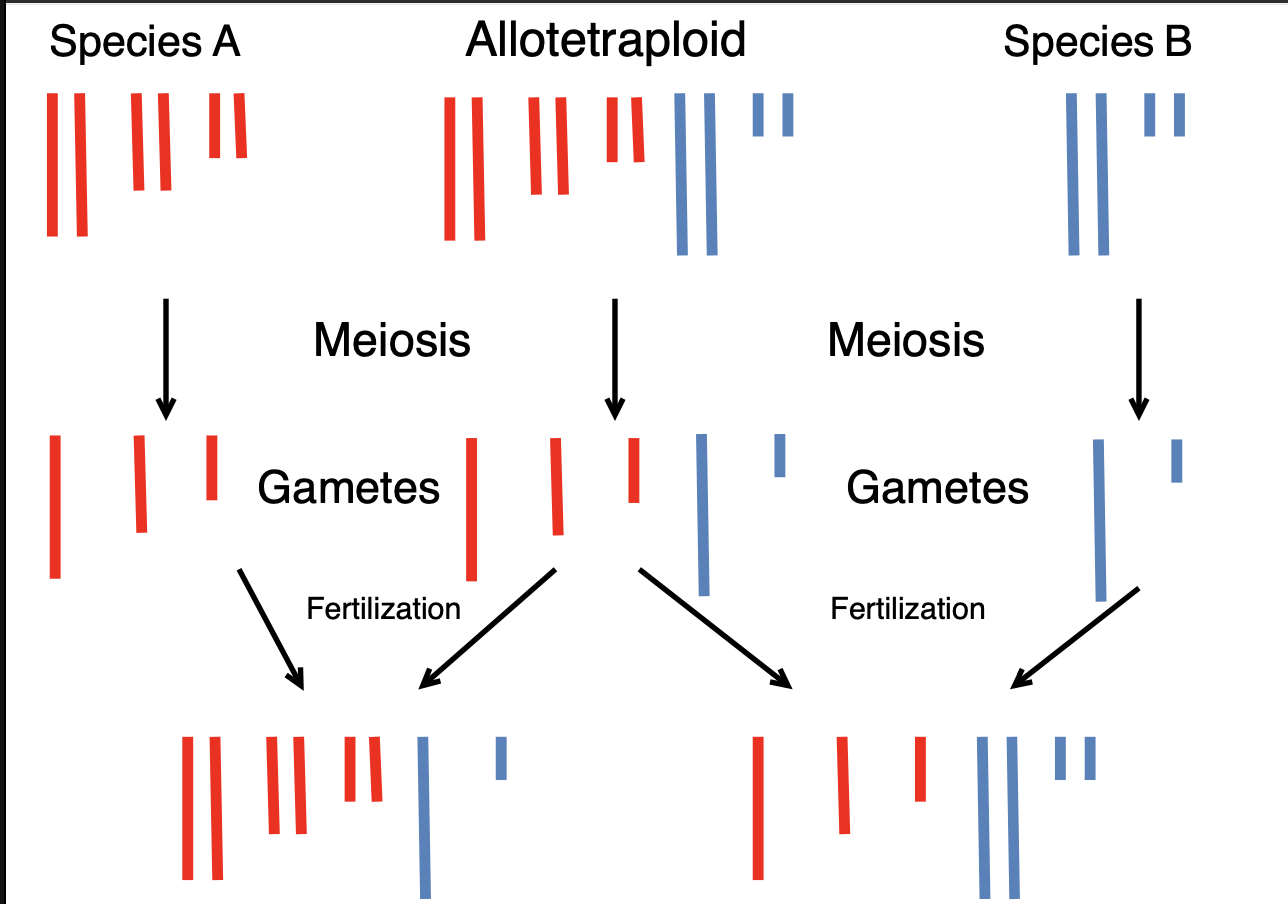
Explain allopolyploidy and diploid parents being reproductively isolated from one another using the Helenium species
H. puberulum (2n = 58) × H. thurberi (2n = 26) → offspring with 42 chromosomes (2n = 42)
H. puberulum was formed with H. thuberi (2n = 26) crossed with H. bigelovii (2n = 32)
it can pair the chromosomes thurberi with thurberi, but bigelovii chromosomes stay unpaired
Offspring have:
26 chromosomes from H. thurberi (diploid set)
16 chromosomes from H. bigelovii (haploid set)
Meiosis problem: only 13 pairs form, 16 unpaired (univalents)
Result: sterile hybrids due to chromosome mismatch
Same issue occurs with H. puberulum × H. bigelovii (45 chromosomes: 16 pairs + 13 univalents)
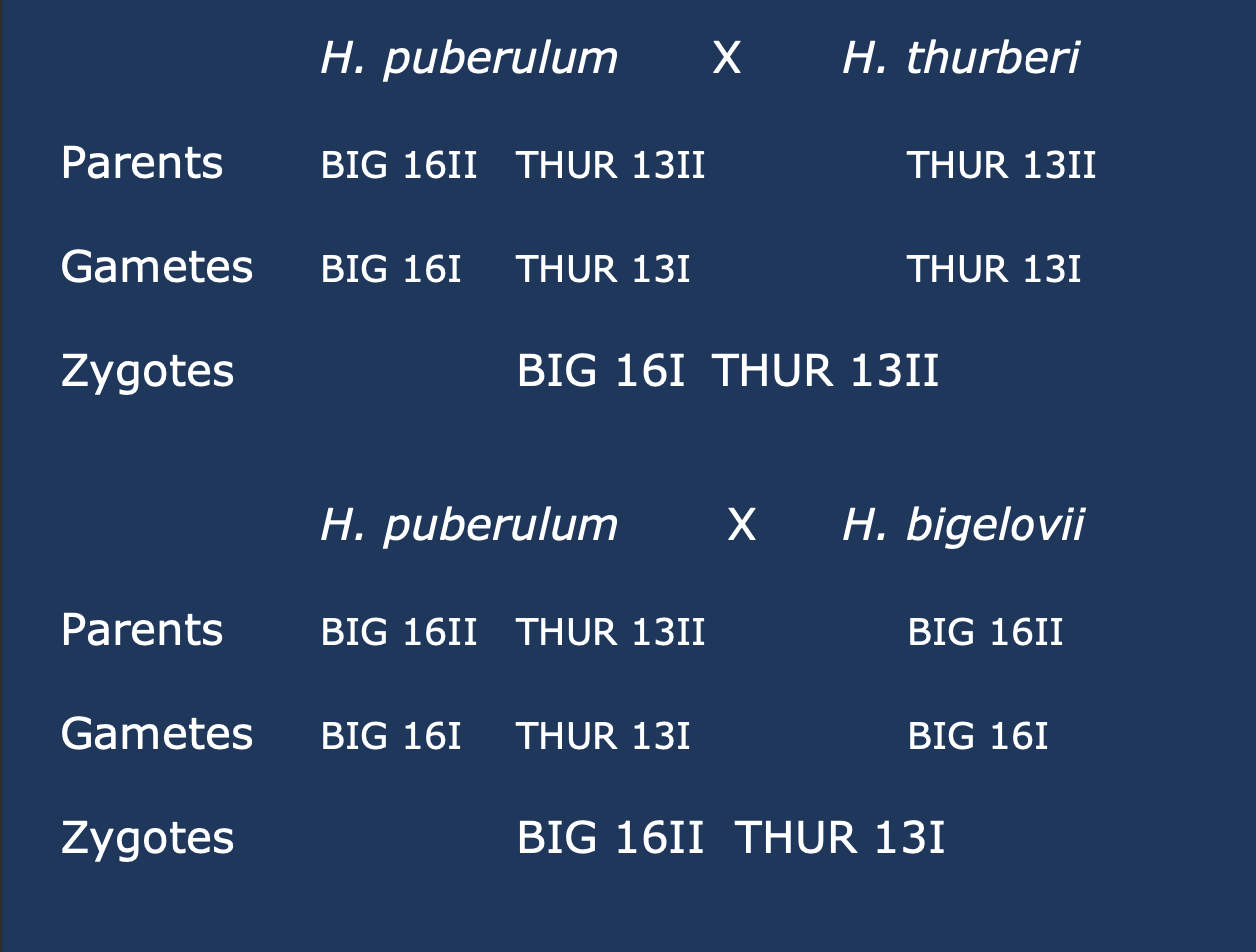
Explain speciation in Mountain Roses
two species of mountain roses diverged via sympatric speciation 3.5 mil years ago
multidimensional scaling found 2 clusters where 11% of genes were fixed for different alleles
phenotypically: 2 different species
further confirmed by phylogenetic analysis that each species was monophyletic clade
flowering time was different: 53 days from each other, 29/30 genes were fixed for different alleles
reproductively isolated
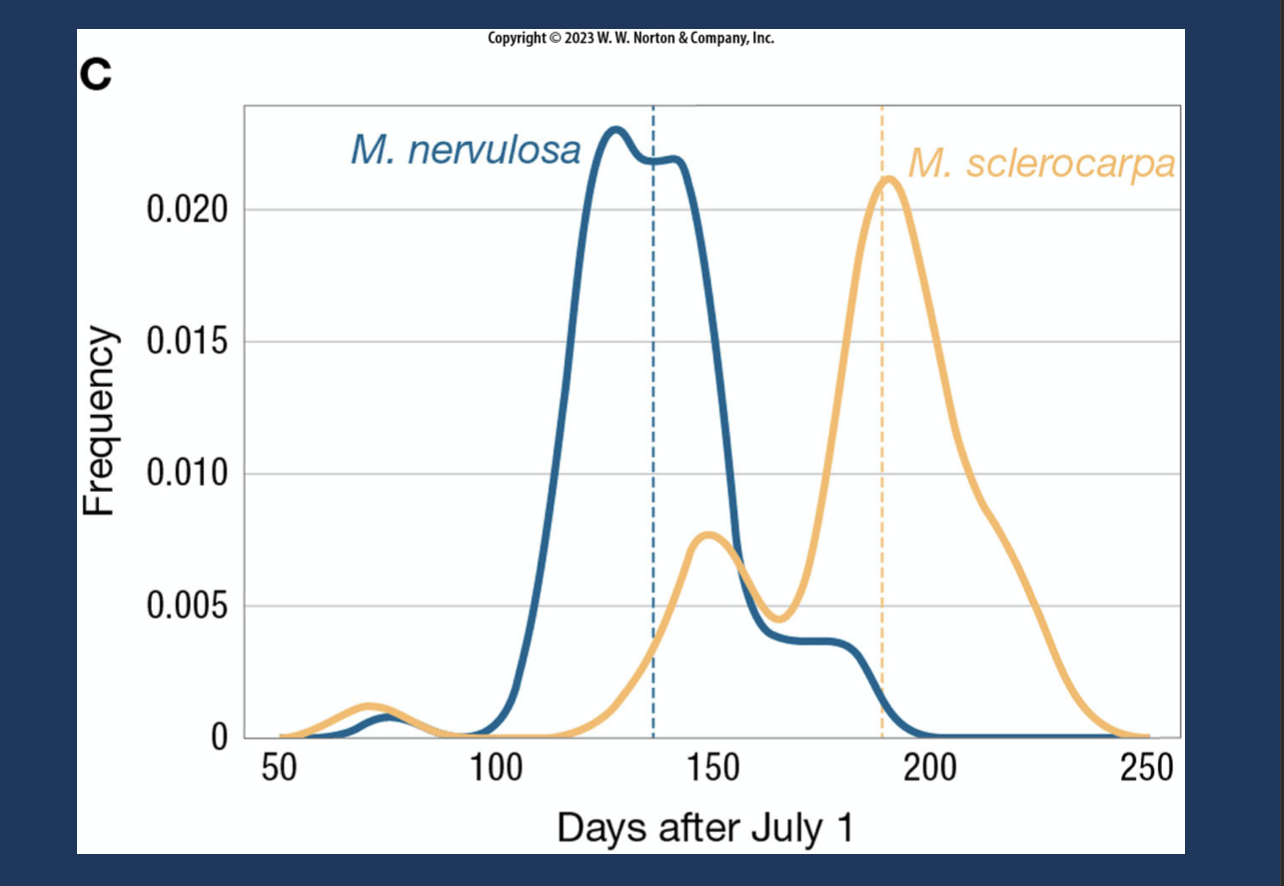
Explain speciation of hawthorn flies and apple maggot fly
Sympatric speciation driven by host plant (food) preference
Original host: hawthorn trees; new host (introduced ~400 years ago): apple trees
Apple maggot fly (Rhagoletis pomonella) became a major pest of apples and also hawthorn trees
About 140 years ago, some Rhagoletis flies switched to apples (host switch)
Hawthorn flies prefer hawthorn fruits; apple flies prefer apples → strong host fidelity
Despite phenotypically indistinguishable, apple and hawthorn flies have different genotypes
Selection acted on 154 genetic loci → evidence for genetic divergence
They are not geographically isolated or by chromosomes, but ecologically isolated (different host species)
Host preference is heritable → offspring inherit fruit preference
Apple and hawthorn fruits ripen at different times → temporal isolation
There is some gene flow, so they are considered incipient species
Scott Egan:
experiment: hawthorn flies exposed to apple development cues showed genetic shift toward apple fly genome
after a single generation of selection, hawthorn genome had huge shift towards apple fly genome
What are incipient species?
Species on the way to becoming species (not speciated completely yet)
What is a cline?
an environmental gradient that can also be a phenotypical gradient
gradual change
What is the deal with the hybrid zone and why is it assumed that it will eventually disappear?
Hybrid zone:
meiosis is irregular due to chromosomes not lining up properly
hybrids are usually at a DISADVANTAGE
reproductive isolation because hybrids are selected against when mating
can vary dramatically in size
Disappear:
genomes could be separated from either side of gradient, so hybrids may be sterile, thus can’t reproduce
hybrids haven’t adapted to being in the middle of the cline
How large is the hybrid zone of the carrion crow and hooded crow in Europe and Asia?
2100 kilometers north to south
50-150 kilometers east to west
What is going on with Sweet Vernal Grass in zinc-contaminated mine areas?
Sweet vernal grass grows in contaminated mine soils with high zinc levels
There's a cline (a gradual change in trait) in zinc tolerance along a soil contamination gradient between pasture vs mine area
Mine populations have evolved zinc tolerance
Mine grasses often self-pollinate or outcross
leading to flowering at different times, reducing interbreeding
Some hybridization occurs at the boundary, but it's limited
Grass in mine area may be in the process of speciating (incipient species)
What is the ecologically bounded hybrid superiority model, and how is it supported by Artemesia tridentata?
This model says hybrids can be more fit than parent species in specific environments.
It assumes genotype-by-environment interaction.
Two Artemesia tridentata subspecies:
tridentata lives at low elevations.
vaseyana lives at high elevations.
Fitness results:
Each parent subspecies is most fit in its native environment.
Hybrids are most fit and at an advantage in the hybrid zone.
The hybrid zone is maintained due to this localized hybrid advantage.
If the process continues, it could result in a new species adapted to the intermediate zone, so 3 species
Explain how ring species like Ensatina illustrate the difficulty of distinguishing between allopatric and parapatric speciation.
Ring species show gradual changes across a geographical barrier with gene flow between subspecies populations
Ensatina salamanders form a ring around a lake in Cali
Each adjacent population can interbreed (like parapatric speciation)
At the southern ends of the ring (populations 8 and 12), there is no gene flow — they are reproductively isolated
These end populations behave as if allopatrically speciated
DNA evidence shows they belong to separate clades and there was no gene flow b/w 8 and 12
What are the two reproductive isolating mechanisms Dobzhansky came up with?
prezygotic and postzygotic
What are the features of prezygotic isolation?
geographical isolation completely
behavioral isolation (meet but no mating)
mate but no gametes transferred
no fertilization happens
What are the features of postzygotic isolation?
zygotes die in embryogenesis
F1 offspring is not viable
F1 offspring survive but are sterile
Future F2 offspring are not viable or sterile
What is secondary contact?
Occurs when two populations that were previously geographically isolated come back into contact
At this stage, they may or may not have completed the speciation process
Hybrids may form if they are not fully reproductively isolated
The fitness of hybrids (viable, inviable, or sterile) determines what happens next
What is secondary reinforcement?
Happens if hybrids formed during secondary contact are unfit (sterile or inviable)
Natural selection favors individuals who avoid mating with the other population (assortative mating)
Leads to evolution of prezygotic isolating mechanisms
finalizes the speciatino process
What is reproductive character displacement?
Natural selection favors changes in reproductive traits to reduce hybridization
The reproductive traits become more different in areas of overlap
Helps reinforce reproductive isolation between species or populations
Explain the situation with Satsuma eucosmia and Satsuma largillierti and reproductive character displacement
These two snail species live in both separate (allopatric) and overlapping (sympatric) regions on Okinawa Island.
Have different penis length in their own regions
In areas where they overlap, their reproductive structures—specifically penis length—diverge more than in allopatric regions
What did Darwin predict about the long-spurred orchid that had a long tubule that leads to nectar?
predicted that there must be an insect (most likely a moth) with an equally long tongue to reach the nectar and pollinate the flower
This prediction was later confirmed when the moth Xanthopan morganii praedicta, with a matching proboscis, was discovered.
Different plant species are populated by _________ organisms, like ____________, ___________, _____________
different; bumble bees; hummingbirds; hawkmoths
What does columbines being pollinated by different species indicate about gene flow, reproductive isolation, and speciation?
decrease gene flow, increase isolation, increase speciation
decrease/no gene flow because different pollinators visit different species.
Reproductive isolation occurs as floral traits evolve to match specific pollinators.
more speciation as isolated populations diverge genetically over time.
What is sexual imprinting?
offspring obtain information about some trait from one or both parents and use that information later in life when they are selecting a mate
Explain the sexual imprinting that occurred with the strawberry poison frogs in Panama
Females prefer males of their own color morph; males are more aggressive toward same-morph males.
Researchers tested purebred, crossbred, and cross-fostered treatments.
Cross-fostered frogs (raised by foster parents of a different morph) preferred the foster morph in mate choice and aggression.
Result: sexual imprinting leads to assortative mating and male-male competition
reduced gene flow among morphs and increased reproductive isolation, promoting speciation
What is a hologenome?
the complete genome of a host species and the genomes of all the microorganisms that are in it
How does the hologenome play a role in speciation? Explain experiment and results
hologenome contributes to speciation because it can lead to mating with same microbiome individuals (same diet)
Fruit flies were raised on two different diets: cornmeal-molasses-yeast (CMY) vs. starch.
Flies preferred to mate with individuals from their own diet treatment.
This suggests diet altered their gut microbiota, influencing mating preference.
How does chromosomal rearrangement lead to reproductive isolation?
Chromosomal rearrangements like translocations and inversions can cause problems during meiosis in hybrids.
If individuals with different chromosome arrangements mate, mismatched chromosomes may lead to duplications or deletions.
inversion loop leads to duplication or deletion
This can lower fertility or cause inviability in hybrids.
Reduced hybrid fitness acts as a reproductive barrier, limiting gene flow.
allows populations to diverge and potentially form new species
How does Dobzhansky-Muller incompatibility theory lead to reproductive isolation?
Independent mutations in two populations (e.g., A₂ and B₂) become fixed.
When hybrids form, A₂ and B₂ interact negatively (epistasis).
A goes to fixation if there is advantage on B background (vice versa)
reduced fitness in hybrids
Selection favors mechanisms that prevent hybridization
postzygotic reproductive isolation and speciation
How does the yeast Saccharomyces model provide support for Dobzhansky-Muller model?
Yeast populations were selected in high-salt vs. low-glucose
Each evolved a beneficial mutation:
High-salt: mutation in PMA1’
Low-glucose: mutation in MKT1’
When crossed, hybrids with both mutations had reduced fitness.
This shows negative epistasis between loci, causing hybrid incompatibility.
postzygotic reproductive isolation
What is adaptive radiation?
the rapid/explosive origin of taxonomic, ecological, and morphological diversity as a result of adapting to novel underutilized ecological niches
How do cichlid fish in East African lakes demonstrate adaptive radiation?
Filled open ecological niches in Lakes Victoria, Malawi, and Tanganyika
Evolved different mating behaviors that reduced interbreeding (only mate with specific pop.)
High mutation and deletion rates may have promoted rapid speciation